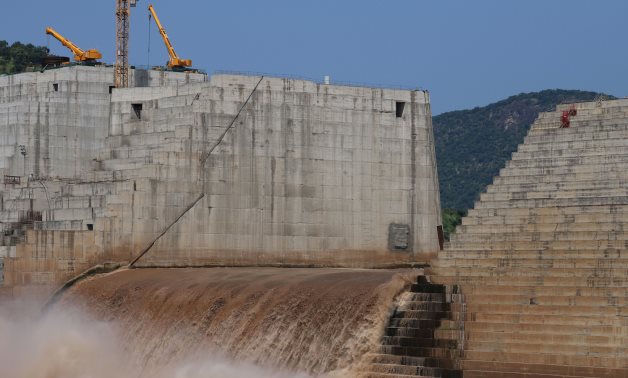
FILE: Water flows through Ethiopia's Grand Renaissance Dam as it undergoes construction work on the river Nile in Guba Woreda, Benishangul Gumuz Region, Ethiopia, September 26, 2019. REUTERS/Tiksa Negeri/
CAIRO – 4 September 2020: A US Department of State spokesperson affirmed that the US has temporarily suspended some aid to Ethiopia upon directives from US President Donald Trump for Addis Ababa’s unilateral act of filling the reservoir of the controversial Ethiopian Renaissance Dam mid-July 2020 before reaching an final agreement with the Nile downstream countries [Egypt and Sudan].
The spokesperson revealed in special remarks to the Associated Press that the US suspension reflected the American concern about Ethiopia’s unilateral decision.
Foreign Policy magazine reported on Friday that US has a plan approved by US Secretary of State Mike Pompeo to suspend about $130 million from the aid.
Washington had brokered a tripartite discussion between the three countries, in presence of the President of the World Bank (WB) starting from November 6, 2019 until February 27 and 28 when Ethiopia apologized for being absent from the negotiations. During these rounds of talks, tangible outcomes were agreed on among the three parties concerning the rules and mechanism of operating the dam and the filling process of the reservoir during the drought and prolonged drought; however, the Ethiopian and Sudanese refused to sign the US/WB-drafted deal.
Few months later, the African Union resumed the talks in July, but nothing was reached due to Ethiopia’s intransigence towards signing an legal binding agreement regulates the operation and filling process among the three countries to avoid possible harms against Egypt and Sudan. In mid-July, Ethiopia announced that it had completed the first phase of the reservoir filling process with 4.9 billion cubic meters.
Since May 2011, Cairo has voiced its concern over how the dam can reduce the country’s annual shares of 55.5 billion cubic meters of Nile water. Egypt’s average water per-capita is expected to drop from 663 cubic meters per year to 582 cubic meters by 2025, according to the Central Agency for Public Mobilization and Statistics (CAPMAS) in 2014.
Constructions in the Grand Renaissance Dam started on April 2, 2011 at a cost of $4.8 billion. It was built by the Italian construction and engineering company Salini Impergilo. The Italian company is headquartered in Milan. The dam is located on the Nile with a capacity of 74 billion cubic meters, and is expected to generate up to 6,000 megawatts of power.
Comments
Leave a Comment